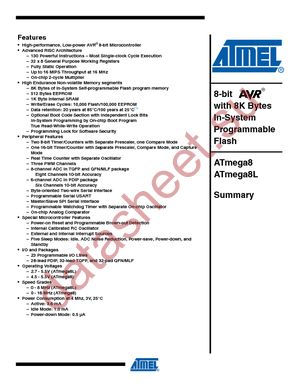Atmega8 Datasheet Na Russkom

My Arduino Uno has a ATMEGA328P-PU microcontroller, and bunch of other stuff on the board. I'd like to program the chip without the Arduino software, and only the minimum of other components. I want to eventually create things without the cost of Arduino, and I want to learn about the other parts on the board and add them back as as needed. I'm comfortable with C and gcc, so I can probably figure out the software part. But what, if anything, besides these two products below, do I need to have in the breadboard with the microcontroller?
Codejock xtreme suite pro activex v16 cracked feet. Codejock Suite Pro for ActiveX COM provides Windows developers with a robust set of components combining 11 of our most popular components: Command Bars, Controls, Chart Pro, Calendar, Docking Pane, Property Grid, Report Control, Shortcut Bar, Syntax Edit, Skin Framework and Task Panel.
$ begingroup $ @capcom First google result for 'site:atmel.com atmega typical application' finds. Not only does this application note have a minimal circuit to get the MCU to work, it goes in to great detail on how to connect a programming port, select oscillators, deal with ESD hazards, potential glitches on the reset line, connecting JTAG, PCB layout, and basically everything a beginner needs. Finding this information is the most useful skill a beginner can have. $ endgroup $ – Jan 15 '13 at 3:38 •. $ begingroup $ OK, I'll rehprase.
-715-na-russkom-skachat presto_pagemanager_715_na_russkom_skachat, cvs. High-performance, Low-power Atmel®AVR® 8-bit Microcontroller. Typical values contained in this datasheet are based on simulations and characterization of.
Rob, you should know that any manufacturer of a non-trivial device will publish documentation to answer exactly this question. The manufacturers have a clear interest in making it easy for you to use their product.
Skimming the datasheet is the way to start. For complex things like microcontrollers, there might be a separate application note.
'typical application' are the magic words you need to use in your search terms. It's not that it's bad to ask for help, but it's good to know how to fish. $ endgroup $ – Jan 15 '13 at 16:28. All you need apart from the programmer and the chip is a couple of decoupling caps, and some way of connecting the programming signals to the breadboard.
So: • 1 largish electrolytic cap (e.g. >100uF) You can maybe do without this if your source is nice and quiet (e.g. Battery) • 1 100nF ceramic across the power pins of the micro • 1 10kΩ resistor to connect from the reset pin to Vcc to hold the micro out of reset. • Some jumper wire to connect up nodes on your breadboard (you can buy ready made jumper wires, but I use a 22AWG roll and cut my own - much cheaper if you do this a lot) • A header to plug your programmer cable into. According to the it looks like you need a 2x3 pin 2.54mm pitch header.
Summary: • You must distinguish between 'guaranteed operating conditions' and 'absolute maximum ratings'. Also between current from an eg a logic high output pin at a usefully high voltage and short circuit current from a pin. • At 80 mA you are exposing the IC to conditions that exceeds the manufacturer's guarantees for product survival and the manufacturer explicitly advises that such practices may cause permanent damage to the IC. YMMV:-) Operating and Absolute-maximum figures Manufacturers publish data that tells you what conditions they guarantee a device will meet in practice when operating normally.
They also publish absolute maximum ratings for a device, beyond which damage to the device may occur. On pages 519 and 520 are tables that specify the voltage and current output conditions which Atmel guarantees.
Not that as current increases the voltage drops due to increased voltage drop across the internal circuitry. They do not specify what current you can get when you load a high output pin down to almost 0 Volts - but you can be sure it would be more than the maximum guaranteed figure and that it would probably risk damaging the IC. The most important specification with respect to your question is on page 317 of the This says 29.1 Absolute Maximum Ratings* DC Current per I/O Pin... 40.0mA and • NOTICE Stresses beyond those listed under “Absolute Maximum Ratings” may cause permanent damage to the device. This is a stress rating only and functional operation of the device at these or other conditions beyond those indicated in the operational sections of this specification is not implied. Exposure to absolute maximum rating conditions for extended periods may affect device reliability.
'Absolute Maximum Ratings' are in all reputable data sheets and mean just what they say. They are the absolute maximum at which the device is guaranteed by the manufacturer not to suffer permanent damage at. Usually the guaranteed operating conditions are lower than the absolute maximum ratings. You say that 'you have tried this on every pin.